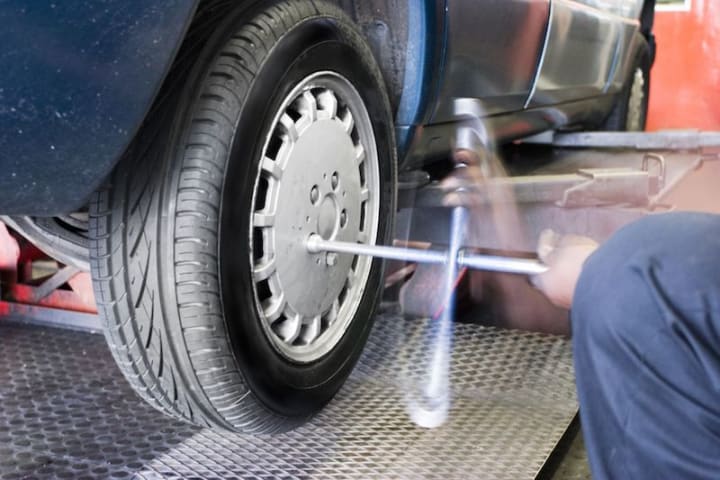How To Change a Tire
It's probably one of the most daunting automotive endeavors you'll ever have to do, and yet learning how to change a tire comes all but naturally following your first successful attempt.

This is one of the most essential car maintenance tips every driver should know, for flat tires are nobody's idea of fun. Before you even start the beginning phase in this tutorial, you'll want to be beyond prepared and that starts with the proper attire. It really comes down to what you're wearing when the incident or discovery takes place, which is why having a few throwaway items in your trunk is recommended. A sweatshirt, poncho, or dirty coat is ideal if you're in colder temperatures, but utmost are gloves. Not only do they protect you from the extreme buildup of grime and dirt, but they can also keep you safe from serious injury.
Your car should already be stacked with emergency-prepared necessities, like a flashlight, a few wheel wedges, and the most necessary of all: a spare tire and jack. I would like to believe every car comes standard with a tire removal kit, but alas this is not always the case. This is the inside of auto repair; knowing your vehicle from top to bottom may not even be enough, even when confronted with something as mundane as a flat tire. Before diving into this lesson on how to change a tire, it's also wise to preview your car's owners manual to make sure you're preforming the procedure correctly and as safely as your manufacturers advise.
Among other things, the Safelife pressure gauge is probably one of the most paramount contraptions you can own in averting consistent, or at least future flat tires. The "other things," I mentioned before includes a spare tire changing repair kit, for which most cars tend to come stock (but, not always). Depending on where you live, I'd consider grabbing some of the best snow tires to get you through the winter.
These are only two of many various essentials for your car emergency kit. Even when you think you're prepared for the worst, chances are you're nowhere even close. Make sure you not only stock your car up on the necessities of bearing any maintenance problem on the road, but that you also have a relatively good handle on the manual.
Engage Emergency Brakes
As soon a you even suspect you've got a flat tire, or loose bolt—whatever the case may be—park your car somewhere safe and somewhere with ample amounts of light. I've been stupid enough to pull off to the side of the road with a nasty flat (or two) and had to do the entire procedure without any sight. Let me tell you this in warning: it's not pleasurable in the least.
Toss on your trusty hazards, because you don't want to get hit (almost happened to yours truly), but most importantly, which can also mean the difference between needing a new trie or needing a new car, engage your emergency brake and parking brake before cutting off the engine. No matter if you're on a rise or on flat terrain, the emergency break will hopefully keep your car gripped to the road so your vehicle doesn't go rolling off into oblivion. There's also wheel wedges you can buy, if it's that serious for you.
Gather the Necessities
Most times, the jack and spare will be found either in the trunk, under the rear of your vehicle, or simply attached to the back. This is why I stressed the importance of reviewing your car's manual, because while you might think you've got all the answers, chances are you'll only make the task that much more daunting.
You haven't even begun to learn how to change a tire, so take your time, breathe, relax, and simply prepare yourself for the worst next few 30 to 45 minutes of your life. What you'll need more or less depends on your car, but essentials include the jack, a tire iron, and your car's spare (which should be checked for tire pressure with your brand new Safelife digital gauge).
Position Jack Under Vehicle
This is among the simplest tasks you'll preform when learning how to change a tire. After you've gathered up all the necessary tools, place the jack where the flat tire is and position it relatively close to the wheel under your vehicle and crank it just slightly upward so it's, in effect, locked into place.
This seems like a rather mundane step, but it simply prepares you for the wondrous job of cranking your car up into the sky. Much about changing a flat is all inherent in preparedness; if you're ready for the onslaught ahead, you'll have it all finished in no time.
Slightly Loosen Lug Nuts
Before you even begin to jack up your whip, first you'll have to go one by one and loosen each lug nut. This, as you will also see later, helps to ensure you stray away from damaging your wheels, but also makes it easier for you to remove lug nuts once your car's lifted.
Some vehicles will even have what's called a wheel cover, or hubcap, which can be easily removed using a screwdriver (another awesome tool to have ready in your vehicle at all times). If the lug nuts show to be too tight at first, use penetrating oil to loosen them further. Never pull up when loosening or removing lug nuts.
Jack Up Your Car

This is definitely the most painful and long lasting tasks in how to change a tire. It's not too physically grueling, it just takes an unruly amount of time to complete (and, even when you often think it's been raised enough, it hasn't). In that case, make sure the jack has raised your vehicle an ample amount of height before attempting to remove the old tire and apply the spare.
Experts tend to say 6 inches is best, but in all honesty it varies across models. One think you should never do in how to change a tire is position the jack directly under the suspension member or axle. Also, before sticking your head up into places and potentially killing yourself, be smart about what you're doing. There are plenty of precautions, but accidents do happen, and safety is of utmost priority whenever preforming maintenance on your vehicle.
Remove Nuts & Wheel
With your vehicle properly raised, upon which your pesky popped tire should be in a slight curvature spin within the wheel cavity, you can then begin to remove the lug nuts.
Using the lug wrench, twist off the remaining nuts and finally remove the flat tire from its prison. Knowing how to change a flat isn't that difficult once you've surpassed the truly grueling parts. The rest of the activity is somewhat smooth sailing, but you should still keep an open eye for any potential issues that could arise.
Apply the Spare
It's best to subdue that inner feeling inside of you, begging and pleasing to rifle your ripped up tire into the wilderness, but that would be defeating the very purpose for you changing the tire in the first place! Leave the flat near your truck for now, as you'll have to affix the spare to your car.
It's, again, relatively simple in theory. All you have to remember in this portion of how to change a tire is to keep the lug nuts somewhat loosely tightened before you descend the vehicle. You should also put all your tools away and prepare to, for lack of a better phrase, ditch the crime scene.
Lower Vehicle & Tighten Lug Nuts

Once the spare, hub cap (if you have one), and lug nuts are all safely re-affixed, leaving the nuts like you did from the beginning; sort of loose, yet still firm in holding the spare back, now you can begin to slowly lower the vehicle without touching the ground just yet.
The thing with those lug nuts is that many people have improperly screwed them back on when first learning how to change a tire in the past without the car being on the right surface. Tightening them while it's is still somewhat suspended in the air will lead to disastrous issues for the long run. Before tightening them completely, allow the car to be fully descended and all other materials safely returned to your trunk.
Fully Descend Vehicle
Similar to how you simply do not want to: 1. drop the vehicle over your foot, and 2. see your hard work go to shit as your spare slides off and tumbles into the ether, make sure the lug nuts are secured with the smallest bit of force, to which you should then tighten as firm as possible once your car's safely on the ground. Remove the jack, and you're basically home free.
Among the most important tidbits in how to change a tire is accepting when to raise and lower the car back onto the pavement. This is where that crucial step where you slightly tighten the lug nuts comes in, because if you preformed any of the previous tasks incorrectly, then you're bound to see continued issues.
Inspect Damaged Tire
Depending on what kind of automobile person you are, you can either take the tire and your car to the nearest shop for an immediate repair, or you can do it yourself right there—that is, only if you've actually got a secondary replacement tire, or at least some sort of adhesive to fix the already damaged one.
More often than not, drivers tend to take their cars to places like AutoZone or Jiffy Lube, where professionally trained experts and technicians will not only fix the damaged wheel and tire, but also may even inspect your car free, or somewhere close to free of charge. Once your vehicle is sporting an all-new and repaired tire, you've finally come full circle in learning how to change a tire.
About the Creator
Johnson Bernard
Father of four, married for twenty years, and yet I still have the energy to type this up at 1 am as little Timmy begins to wail from upstairs. I'm a fixer-upper and a family man.






Comments
There are no comments for this story
Be the first to respond and start the conversation.